
Before there were several generations of Canadarm and Chris Hadfield, there was Alouette 1, Canada’s first satellite and the first collaboration between Canada and NASA. This Week in Space History has that story.
Alouette 1 began as a project of the International Geophysical Year of 1957 to 58, much like the first satellites of the U.S. and USSR. A Canadian government organization named the Defense Research Telecommunications Establishment responded to a NASA Request for Proposals in December 1958, starting the project. The satellite was designed to study the upper half of the ionosphere, something not possible from the surface of the Earth. To do this, it would carry an instrument similar to the type used to study the ionosphere from the surface, called a sounder. Canada would build the satellite and NASA would launch it and allow the use of its extensive ground station network to receive data from it. The UK also contributed two ground stations in exchange for access to the data.
All of these ground stations were critical to the success of the project because the Alouette 1 satellite lacked onboard data storage. It gathered data continuously but only sent it back while in contact with the ground. Engineers chose this to make the most reliable satellite possible with the technology of the day.
With agreements in place, work got underway to prove that the planned instruments would actually work in space. To do this, two antennae, similar to the ones that would be on the satellite, were launched on a sounding rocket into the ionosphere on two occasions in 1961. The tests were successful.
Alouette 1 launched with two radio antennas for its experiment, one almost 46 meters in size and the other nearly 23 meters, which were deployed from inside the spacecraft when it reached orbit. These were the longest antennas launched at the time.
Alouette 1 was launched from Vandenberg Air Force Base Site 75-1-2, now known as SLC-2W at Vandenberg Space Force Base, on September 29, 1962, aboard a Thor-Agena rocket. It was put into a 1000-kilometer orbit inclined 80 degrees to the equator. Alouette 1 operated for ten years, despite a decrease in its spin rate and the Starfish Prime space nuclear test several months prior to its launch which damaged or destroyed ten other satellites.
The success of Alouette 1 led to an expanded program called the International Satellites for Ionospheric Studies, which continued with a further five satellites operated through 1990. Alouette 2 was launched in 1965; it was the flight spare for Alouette 1 refurbished for flight.
The expanded program included France, Norway, Japan, New Zealand, Australia, Finland, and South Africa.
More Information
Alouette 1 (NASA)
Alouette-ISIS Program Summary (NSSDC/IEEE)




 Join the Crew!
Join the Crew!
 Escape Velocity Space News
Escape Velocity Space News
0 Comments